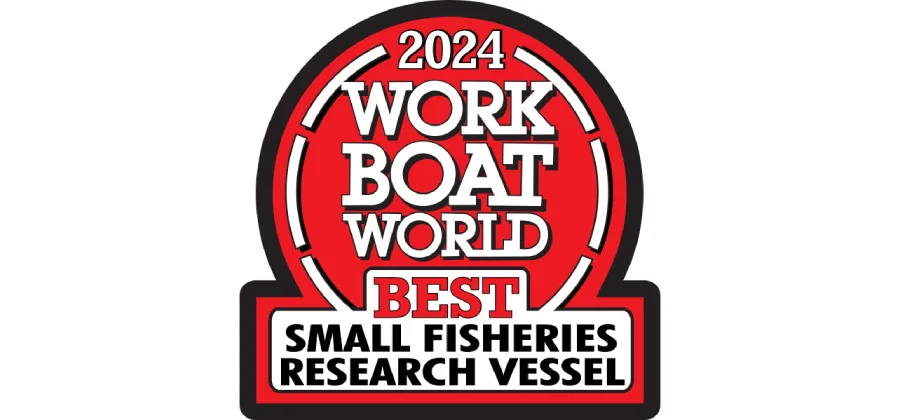AWARDS 2024 | Best Small Fisheries Research Vessel – Dra. Barbieri – NavalPro
This very impressive fisheries research vessel is very much “a quart in a pint pot”. An enormous amount of capability has been packed into a comparatively small ship. That requires, though, that it must be a complex vessel with all the design intricacies that necessitates.
Diesel-electric propulsion is just the start of that complexity with its goal of almost completely silent operation. The ship had to be seaworthy enough to work in the open ocean while, at the same time, being capable of shallow inshore work. It was a difficult design process that fully achieved its complicated objectives.
"Dra. Barbieri, with its 30.8 metres length and a draught of less than three metres, is the smallest fisheries research vessel that complies with the silent vessel notation ICES 209, making it a very special vessel," Javier Benard, NavalPro's CEO, told Baird Maritime.
"This state-of-the-art compact research platform was initially based on a concept design from Australia and [further] developed by our firm. The scope included structural and systems design, also VR space evaluation and CFD optimisation validated in the local towing tank at the Universidad Austral Chile."
Benard said the vessel was built on schedule and to a high-quality standard. In his view, those attributes indicate "a very special technological effort" for a country like Chile to produce its own coastal fisheries research vessel from tender concept phase to completion.
This compact research platform was initially based on a concept design from Australia and [further] developed by our firm.
For Benard, the main difficulties in designing the vessel were related to its size and its ability to perform in confined and shallow waters while also complying with the ICES 209 silent notation.
"This was a requirement set by Chile’s Undersecretariat of Fisheries and Aquaculture, as it realised that many of the fisheries research vessels operating in the country cannot operate in certain fjords and rivers due to their large size."
"At an early stage of the design, part of our team performed a technical trip to Spain in 2019 to meet shipyards and suppliers. At that time they were delivering the most advanced research vessels."
Benard explained that NavalPro met with technical advisors for propulsion and noise reduction, and the company eventually understood that work on the propulsion configuration was the key to complying with the silent notation.
"We migrate[d] from one to two propulsion lines to reduce propeller loads and its consequent irradiated noise," said Benard. "The diesel electric propulsion was configured with generators on double elastic beds. We performed several CFD analyses to discard bubble sweep under the prospection instruments and align[ed] every appendage to streamlines to reduce cavitation and underwater noise."
Benard said the main lesson learned was in integrating all technologies as a complete package within a very restricted space.
Benard believes new international and local regulations for emissions have led to the development of features such as optimised hull forms, better propulsion performance, and alternative fuels.
"The use of full electric vessels on ferries and tugs is now a reality for nearshore applications," he told Baird Maritime. "These trends [have an] impact on the vessel layout, especially for new spaces for batteries and controllers."
The use of new sources of energ[y] like fuel cells or wind for propulsion will be important, as well [as] the use of ROVs or autonomous drones.
Benard explained that NavalPro's market is based mainly on workboats such as pilots boats, ferries and aquaculture support vessels.
"Due to a stagnant global economy, new projects are few. However, the Chilean Navy is promoting a continuous naval building plan to replace its fleet using local suppliers as consultancies and shipyards. For NavalPro, this set new opportunities [for us] to use our capabilities in marine design on a new scale."
Benard said that polar exploration, decarbonisation and autonomous vessels would be the main trends that will become increasingly important within the research vessel industry.
"These new vessels represent a global effort to improve our understanding of the oceans and polar regions, with a focus on sustainability and advanced research capabilities.
"The use of new sources of energy like fuel cells or wind for propulsion will be important, as well as the use of ROVs or autonomous drones to collect samples and data, and research vessels would become more like mother ships than research platforms."
Benard said that NavalPro has begun work on a conceptual design for a hybrid pilot boat and two aquaculture support vessels that would have their generators replaced with lithium polymer batteries to reduce noise and fuel consumption at night while anchored.
"Workboats are required in any coastal nation and those nations in South America are no exception," he told Baird Maritime. "Countries like Colombia, Ecuador, Peru and Chile are looking to use their navies' shipyards as platforms for technology transfer, setting new standards for the region.
"We hope to also benefit from this new standard for all of South America as a world-class marine consultancy."
For a list of the 2024 "Best Of" award winners, please click here.

